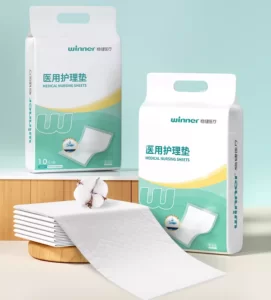Breast overflow is a common phenomenon among postpartum mothers. During the menstrual period, the mother’s milk is always in a state of “exploitation”. As the baby sucks, there will be more and more milk. The breast is like a bottle, when the water is full, the water will come out, so the milk will also spill out. Then at this time, the breastfeeding pad should play its role.
1. Knowledge about nursing pads
(1) To buy or not to buy nursing pads?
Is it really necessary to buy nursing pads? Is there no need to buy them if you have less milk? I believe that many new mothers have similar questions.
Let’s first understand the role of nursing pads: nursing padsare placed inside the bra to prevent new mothers from getting dirty clothes while nursing and to protect the nipples, especially suitable for working women or for use on the go. For mothers with more milk, breastfeeding pads are necessary! For those who have less milk, you can use them for parties or other specific occasions as needed.
(2) When should I use nursing pads?
During the first 6 to 10 weeks of breastfeeding, you are most likely to experience “overflow”, especially in the morning, so pads can come in handy! In addition, while your baby is sucking on one breast, the other breast will keep spilling milk, so it is best to put a breast pad on in advance.
(3) How often should I replace mynursing pads?
Generally speaking, as long as the breastfeeding pads are full and the breasts feel heavy, then it may be necessary to replace them. But even if there is only a small amount of milk secretion, it is still recommended that mothers change their breastfeeding pads every 3 to 4 hours, because the nutritional content of milk is very high, and not changing them for a long time can easily lead to bacterial growth and endanger the health of mothers’ breasts.
(4) How to choose nursing pads?
For the selection of nursing pads, there are three aspects as main consideration.
Material: breastfeeding pads are intimate hygiene products, so the fabric should be comfortable and skin-friendly, which is particularly important.
Absorption: observe whether the absorption of the breastfeeding pad is large enough to reduce the frequency of replacement.
Absorption speed: observe the absorption speed and whether it is clean and fresh after use.
2. Hidden uses for nursing pads
Winner Nonwovens’ technology supports diverse needs:
Elderly/Paralysis Care: XL pads secure bedding/wheelchairs; prevent skin irritation.
Pet & Incontinence Use: Rapid absorption neutralizes accidents instantly.
Post-Surgery/Postpartum: LeakGuard™ shields stitches or C-sections.
Baby Hygiene: Infant-sized pads handle diaper leaks or spit-up emergencies.
3. Why Winner Nonwovens’ Nursing Pads Stand Out
Engineered for maximum protection and adaptability, Winner Medical’s Guard Pro Series Nursing Pads deliver unmatched performance:
Dual-Size Flexibility: Adult XL (60 * 90cm) for full-body coverage + Infant sizes for delicate needs.
12-in-1 Protection: Safeguards wheelchair users, incontinence care, pregnant/postpartum moms, surgical recovery, pets, paralysis patients, overnight periods, bedridden care, baby hygiene, and outdoor emergencies.
3x Hyper-Absorbency: Rapidly locks away 3x its weight in fluids (milk, sweat, urine).
PE LeakGuard™ Barrier: Waterproof backing prevents seeps onto clothes or bedding.
3D Honeycomb Weave: Channels liquids downward instantly; stays dry against skin.
Disposable Hygiene: Replace every 3 hours (or when saturated) for freshness and safety.











